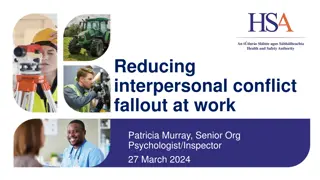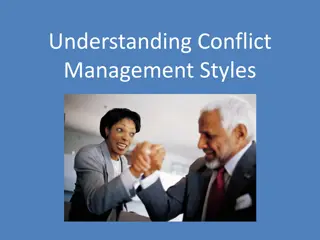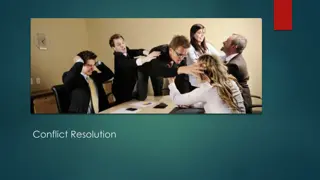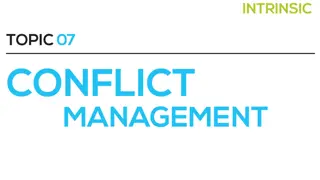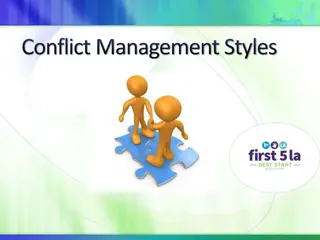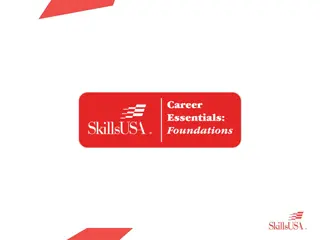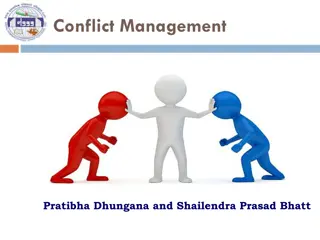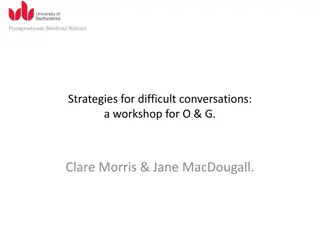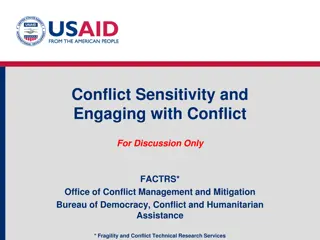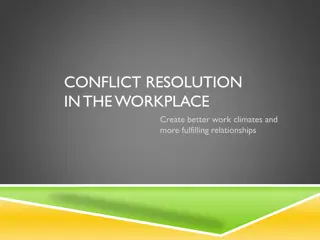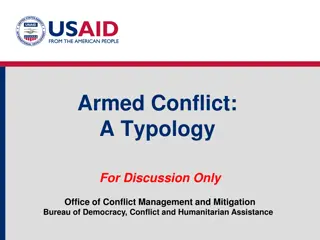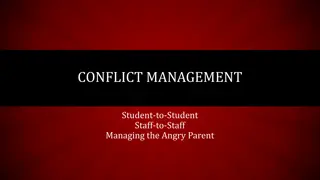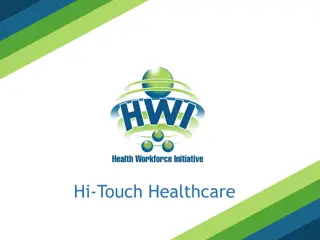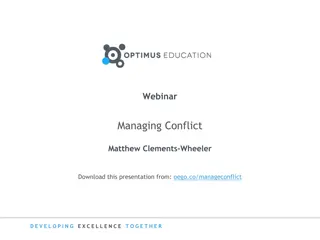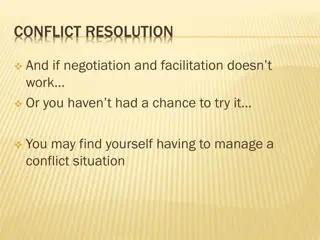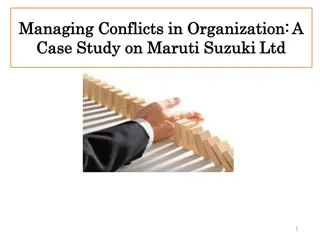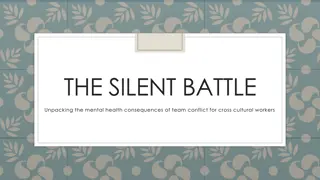Conflict Management Strategies for Effective Team Performance
Explore the importance of conflict management within teams, common conflicts in drug court teams, barriers to healthy conflict management, and strategies to enhance conflict resolution. Understand the misconceptions and truths about conflict, how process conflict impacts group performance, and the benefits of systematic conflict management in improving outcomes.
Download Presentation

Please find below an Image/Link to download the presentation.
The content on the website is provided AS IS for your information and personal use only. It may not be sold, licensed, or shared on other websites without obtaining consent from the author. Download presentation by click this link. If you encounter any issues during the download, it is possible that the publisher has removed the file from their server.
E N D
Presentation Transcript
MANAGING CONFLICT WITHIN YOUR TEAM: FINDINGS AND RECOMMENDATIONS FROM HARVARD Alex Casale New Hampshire Statewide Drug Court Coordinator Heather Kulp New Hampshire Judicial Branch Circuit Court Administrator
What Well Do Today 1. Identify why conflict management is important 2. Understand common conflicts within drug court teams 3. Explore barriers to healthy conflict management 4. Explore ways to better manage conflict in your drug court teams
WHY IS CONFLICT MANAGEMENT IMPORTANT?
What We Believe About Conflict Conflict is bad Conflict means we re not good people/workers/team members Conflict is the other guys fault Conflict occurs when rational people become emotional Conflict is to be avoided Conflict is exciting!
What is True About Conflict Conflict is value neutral Conflict is the natural result of human difference We all contribute to conflict Emotions cannot be eliminated Rationality isn t the anecdote to conflict Conflict, if managed badly, can negatively impact even the best projects and people Conflict can be managed well
Process Conflict is as Important as Task Conflict Process conflict, as distinguished from task conflict, negatively affects group performance, member satisfaction, and group coordination. Conflict in Small Groups: The Meaning and Consequences of Process Conflict, Small Group Research 42(2):127-176 April 2011
Systematic Conflict Management Improves Outcomes Groups that developed integrative conflict management styles made more effective decisions than groups that utilized confrontation and avoidance styles. Groups that never developed a stable style were also less effective than groups with integrative styles. Do conflict management styles affect group decision making? Evidence from a longitudinal study. Available from: https://www.researchgate.net/publication/227735347_Do_conflict_management _styles_affect_group_decision_making_Evidence_from_a_longitudinal_study
Phases of Conflict Processing Prevention Management Resolution
ASSESSMENT OF NEW HAMPSHIRE DRUG COURT TEAMS Conducted by Harvard Negotiation & Mediation Clinical Program in Spring 2018
Think of a time on your drug court team when a disagreement/conflict between team members was HELPFUL. Think of a time when a disagreement/conflict was UNHELPFUL.
We All Handle Conflict Differently True Color personality test Blue Gold Green Red Myers-Briggs Personality Type Indicator 16 different types of personality EQ Depending on your EQ people might be able to shift temporarily to a different personality type
Conflict is an inherent and potentially productive feature of drug court teams.
Questions we explored What conflicts come up on teams? How are they being managed? How do people perceive the management? How is the way they are being managed impact performance? How can teams improve conflict management?
Sources of unhelpful conflict Decisionmaking: Admissions, sanctions, termination Team members dual roles Ineffective communication systems
Admissions * Sanctions * Termination Admissions decisions can reflect differing views and approaches to drug court Sanctions discussions are seen as inefficient Termination decision-making lacks clear, shared criteria
Team members dual roles Conflict over external resources promotes performance- detracting power struggles in hierarchical teams. Team members must navigate conflicting confidentiality standards. Some drug court decisions can be seen as threatening foundational professional principles Organizational commitment to drug court differs in strength and purpose.
Communication Staff meetings are time-bound in a way that doesn t necessarily reflect the needed resource for decision- making. It is not always clear who is actually making decisions, particularly in core team/drug court team models. Participants may split staff, making communication about the participant more difficult.
Sources of unhelpful conflict Decisionmaking: Admissions, sanctions, termination Team members dual roles Ineffective communication systems
What About Drug Court Teams Keeps the Conflicts from Being Managed Well?
HOW TO BETTER MANAGE CONFLICT
Recommendations 1. Establish regular policy meetings 2. Improve feedback systems 3. Create space for sharing across drug courts at trainings 4. Establish team norms according to role definitions in MOU 5. Use data to better evaluate team performance 6. Implement more detailed decision-making tools 7. Clarify staff splitting resolution process
Effective Conflict Management Prevention Management Resolution
Effective Conflict Prevention: Policy Meetings & Team Norms Establish team norms, empower all to enforce them Create an environment in which people are welcome to raise differences, concerns, alternative views Identify a purpose for each activity Be clear about what people s roles are Address people s core concerns Appreciation Autonomy Affiliation Role Status
Effective Conflict Management: Decision- making Tools & Staff-splitting Practices Be willing to take initiative in raising a concern Name a dynamic you are sensing Be transparent about your own thinking/feeling Own your own contribution; do not attribute intention or blame to others Invite people to share what they re thinking/feeling Consider one-on-ones Recognize authority and use it sparingly Rely on objective criteria to make decisions
Effective Conflict Management: Improve Feedback Systems Create constant feedback loops with stakeholders those impacted decision-makers implementers informers Engage in systematic review of how things went
Improve Feedback Systems: Primary Questions What s working well? What could we be doing differently?
Improve Feedback Systems: The Circle Chart Causes Solutions Diagnoses Prescriptions Symptoms Actions Effects Specific Steps The Circle Chart was first introduced by Roger Fisher & William Ury, Getting to Yes (1983).
Effective Conflict Resolution: Share Across Teams Sit on the same side of the problem Identify a purpose for coming together Work systematically through The Circle Chart Select an action that may have the most impact All commit to the action Set a check-in time Try another action Bring in a third-party if you re stuck
Individual drug court team Hold monthly or quarterly policy meetings Establish team norms Track relevant team data and set aside time for review and discussion biannually Develop agreed-upon criteria and tools for decisionmaking on admissions, sanctions, and termination For substantive guidance, consult decisionmaking tools and utilize knowledge of other counties practices as appropriate Call on and enforce team norms Address staff-splitting concerns in court sessions Implement Difficult Conversations Checklist Statewide program Offer training on giving and receiving feedback Conduct survey of team dynamics Reserve time at trainings for cross- county sharing Create and distribute contact list Provide guidance and/or training to teams on developing team norms that align with team members roles Integrate staff-splitting into trainings Provide guidance to individual team members experiencing high-intensity conflict, such as using the Difficult Conversations Checklist Intervene on a case-by-case basis to provide support and/or mediation Preventive mechanisms Live interventions This chart was adapted from one developed by Bill Ury, Cathy Costantino, and Christina Sickles Merchant to illustrate a spectrum of ADR options in different systems. Cathy A. Costantino & Christina Sickles Merchant, Designing Conflict Management Systems: A Guide to Creating Productive and Healthy Organizations 127 (1996).
Create a culture in which difference is welcome and encouraged Recognize and address core emotional concerns Rely on agreed-upon objective criteria for making decisions Regularly review how the team is working together Address symptoms of conflict in a systematic, action-oriented way Team Health Check hkulp@courts.state.nh.us acasale@courts.state.nh.us


